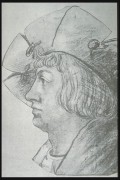Ludwig Senfl facts for kids
Ludwig Senfl (born around 1486, died between 1542 and 1543) was a famous Swiss composer. He lived during the Renaissance period and worked mostly in Germany. Senfl was the best student of another well-known composer, Heinrich Isaac.
He became the music director for Emperor Maximilian I, Holy Roman Emperor. Senfl was very important in developing a style of music called polyphonic music in Germany. This style came from the Franco-Flemish region. Both Senfl and his teacher Isaac helped make German folk songs popular. They also used these folk songs to create more complex polyphonic pieces.
Senfl's Life Story
Ludwig Senfl was likely born in Basel, Switzerland, around 1486. He lived in Zürich from 1488 to 1496. Then, he joined the choir of Emperor Maximilian I's court in Augsburg. This group was called the Hofkapelle. After 1496, he probably never lived in Switzerland again, except for a short visit in 1504.
In 1497, he moved with the Hofkapelle to Vienna. Between 1500 and 1504, he likely studied music there for three years. This was a common path for choirboys whose voices had changed. During this time, he studied with Heinrich Isaac. By 1509, Senfl was working as Isaac's copyist. He copied a large part of Isaac's huge work called Choralis Constantinus. Senfl later finished this work after Isaac passed away.
After a trip to Italy around 1508-1510, Senfl returned to the Hofkapelle. When Isaac died in 1517, the Emperor chose Senfl to take his place. He became the court composer. In 1518, Senfl had a hunting accident and hurt his foot. This injury kept him from working for about a year.
When Emperor Maximilian died in 1519, Senfl lost his job. Things became difficult for him. The new Emperor, Charles V, let go of most of Maximilian's musicians. He even refused to pay Senfl the money he had been promised. For the next few years, Senfl traveled a lot, looking for work. He also continued to compose music. In 1520, he helped edit a collection of motets called Liber selectarum cantionum.
Senfl attended an important meeting called the Diet of Worms in 1521. He never officially became a Protestant. However, he seemed to agree with Martin Luther's ideas. Later, he was questioned about his beliefs and chose to give up his role as a priest. Senfl wrote many letters to important people like Duke Albrecht of Prussia and Martin Luther. This correspondence started in 1530.
Eventually, Senfl found a job in Munich. This city had high musical standards and needed new music. It was also quite open to people with Protestant ideas. Senfl stayed in Munich for the rest of his life. By 1540, he was ill, as shown in his letters. He likely passed away in early 1543.
Senfl's Music and Its Impact
Senfl was a very flexible composer. He wrote both religious and non-religious music. His style was inspired by earlier composers from the Franco-Flemish region, especially Josquin des Prez. Senfl was especially good at creating beautiful melodies. His music had a warm, singing quality. It remained popular and important in Germany even into the 1600s.
His religious music included masses, motets, and settings for vespers and the Magnificat. Some parts of his music used older techniques, like cantus firmus. This was more popular in the 1400s. He even sometimes used isorhythm, another older style. But he also liked to use melodic parts that sounded good when sung. These often used parallel intervals like 3rds and 6ths, which was typical for German music.
Senfl also wrote many German lieder. Most of these were non-religious songs. A few were religious songs written for Duke Albrecht of Prussia. These songs varied a lot. Some were very simple settings of a cantus firmus. Others were very complex, like elaborate canons and quodlibets.
See also
 In Spanish: Ludwig Senfl para niños
In Spanish: Ludwig Senfl para niños


